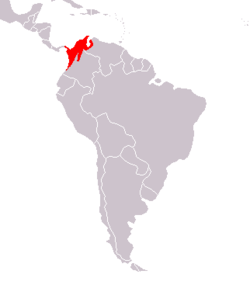Top Qs
Timeline
Chat
Perspective
Lesser capybara
Species of rodent From Wikipedia, the free encyclopedia
Remove ads
The lesser capybara (Hydrochoerus isthmius) is a large semi-aquatic rodent found in South America that has vast similarities, yet subtle differences, with the common capybara (Hydrochoerus hydrochaeris), the largest species of rodent in the world.[2]

Remove ads
Habitat
The lesser capybara mainly inhabits areas close to water such as marshes, ponds, and lagoon habitats as these places offer water, which is essential for these capybaras to fulfil their niches' of maintain body temperature homeostasis, provide suitable food, hide from predators, and mate. They were first observed in Pacific river valleys in Panama as early as 1912 as a subspecies of the common capybara. However, after thorough studies on the anatomy and genealogy of them, the lesser capybara was classified as its own species some time in the 1980s.[citation needed] Currently, this species has expanded its range to parts of Eastern Panama and Western Colombia and Venezuela, just west of the Andes Mountains. The lesser capybara constitutes the northernmost population of any extant capybara species,[2] other than the now extinct H. hesperotiganites from Pleistocene California.
Remove ads
Diet
Lesser capybaras are herbivores that mainly graze on grasses and other aquatic plants. However, during dry seasons when their main source of food is depleted, the lesser capybaras will tend to feed on reeds, grains, melons, and squash. On average, an adult will eat 6 to 8 pounds (2.7 to 3.6 kg) of this food per day. Although not a main part of their diet, lesser capybaras will also eventually ingest their own feces to gain bacteria that benefits them in breaking down thick fibers eaten.[3]
Remove ads
Physical description
Just like greater capybaras, the lesser capybara is characterized by short, brown hair, with blunt snouts, four short legs (front legs are smaller than hind), partially webbed feet, small eyes and ears situated high on their head, and a very tiny tail.[4] Compared to greater capybaras, the lesser capybara is generally smaller in size, with adults growing up to 3 feet (90 cm) in length, weighing up to 62 pounds (28 kg), and having a darker brown coat.[citation needed]

Adaptations
As animals that are considered prey for many animals, the species is very wary of predators and likes to travel in groups of about 20 cavies.[5] As a result, the capybaras have adapted to be excellent swimmers and dive regularly in water to avoid predators such as jaguars and anacondas.[4] Having eyes and ears placed high on their heads, the capybaras can see these predators while in the waters. Furthermore, being immersed in water for long periods of time helps the capybaras regulate their body temperature by helping them cool off.[6]
Remove ads
Mating
The lesser capybara breeds year-round, only in water.[6] Lesser capybara females, when in estrus, will whistle through their nose to attract males. Females have a gestation period of roughly 108 days, and giving birth to litters of about 3 to 4 baby pups.[citation needed]
References
Wikiwand - on
Seamless Wikipedia browsing. On steroids.
Remove ads



